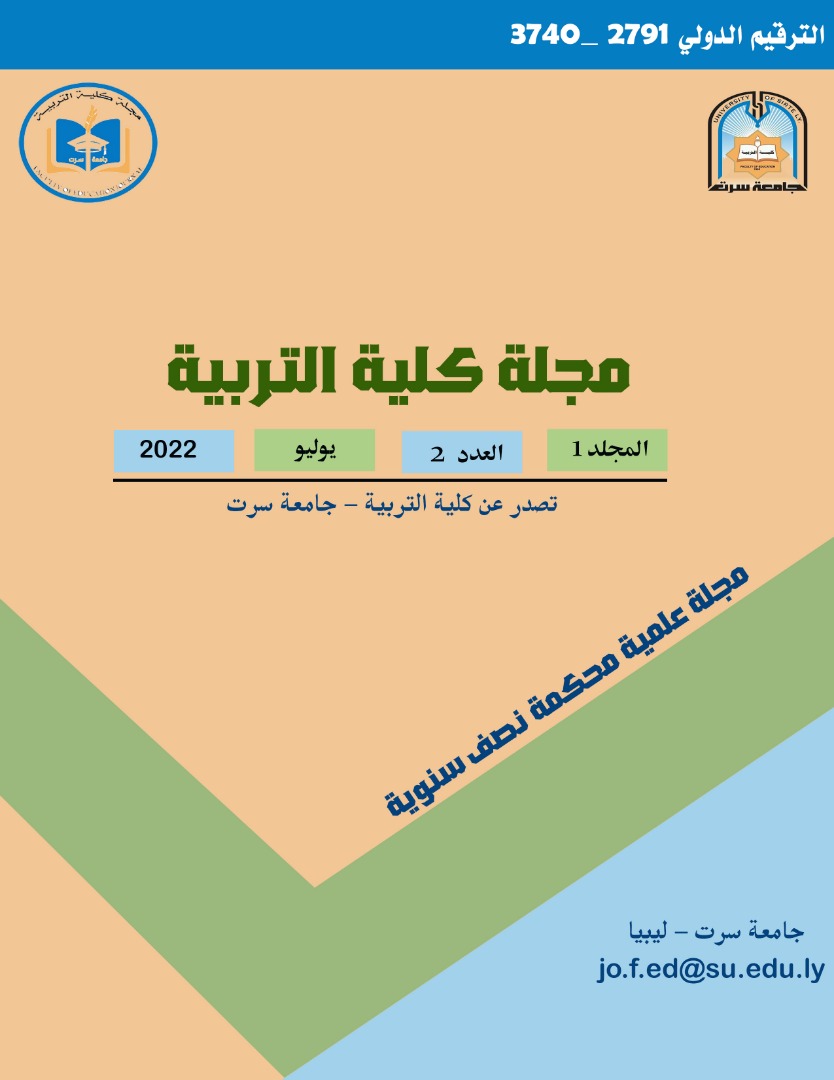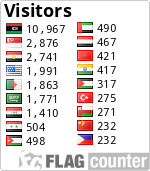An Alternaria Leaf Spot of the Swiss Chard in Tripoli- Libya
DOI:
https://doi.org/10.37375/foej.v1i2.491الكلمات المفتاحية:
Swiss chard disease, Beta vulgaris, disease incidence, disease severity, Alternaria alternata.الملخص
This research was conducted to study the disease incidence (DI%) and disease severity (DS%) of the Swiss Chard disease caused by Alternaria alternata on Swiss Chard crops at four sites of Tripoli; Soq – Aljumma, Al-ghrarat, Al- Harart and An-Nofleen. A total of 100 plant samples were collected during this study. Results showed that percentage of disease incidence and disease severity varies among the surveyed locations. The results also showed that the five selected Beta vulgaris yielded different susceptibility. Barese was the high susceptible to the pathogen in (DI %) and (DS %), under greenhouse condition compared to control, whilst, Orange Fantasia was the lowest susceptible. In addition to that, Fordhook Giant was high susceptible under field conditions, also Celery was less favorable under greenhouse conditions compared to others. Parsley was less favorable under field conditions compared to other hosts tested. Alternaria alternata has a wide host range include all tested plants with different (DI%) and (DS%).
المراجع
Amin, M; Malik, A.U; Khan, A; S. and Javed, N. (2011). Potential of fungicides and plant activator for postharvest disease management in mangoes. Int. J. Agric. Biol. 13, 671–676.
Agnes, A. (2009). Distribution and Characterization of sweet potato Alternaria blight isolates in Uganda. M.Sc. Thesis ;College of Agricultural and Environmental sciences- Department of Crop Science, Makerere University,pp56-57.
Bhat, H. A; Ahmad, K; Ahanger, R. A; Qazi, N. A; Dar, N. A. and Ganie, S. A. (2013). Status and symptomatology of Alternaria leaf blight (Alternaria alternata) of Gerbera (Gerbera jamisonii) in Kashmir valley. African Journal of Agricultural Research. 8 (9) :819-823.
Choi. Y. W. (1999). Fungal Diversity 3:9. http://www.fungal diversity.org/fdp/sfdp/FD_3_29-38.pdf Google Scholar. Accessed on 27.4.2022
Coates, L. and Johnson, G. (1997). Postharvest diseases of fruit and vegetables, in Plant Pathogens and Plant Diseases, eds Brown J. F., Ogle H. J. (Armidale, NSW: Rockvale Publications), 533–548.
Dudhe, M.Y. and Bharsakle, S. S. (2005).Screening of germplasm line for resistance to Alterneria blight and necrosis disease in sunflower. Crop. Prot. Prod. 1:84–87.
Elena, K. (2006). Alternaria brown spot of Minneola in Greece; evaluation of citrus species susceptibility. Eur. J. Plant Pathol. 115, 259–262.
Ellis, M. B. (1976). More Dematiaceous Hyphomycetes. Commonwealth Mycological Institute: Kew, Surrey, U. K.
Garg, A and Singh, S. (2016). Alternaria species in aerospora of vegetable and fruit market at Agra and their mycotoxigenic potential. Asian J. Agric. Life Sci. 1:4–7.
Goh T.K. (1999). Single-spore isolation using a hand-made glass needle. Journal of Fungal Diversity 2: 47−63.
Harveson , M. R; Hanson, E.L. and Hein, L.G. (2010).Compendium of Beet Diseases and Pests,Second Edition.The American Phytopathological Society. Pp12-13.
Horst R. (2008). Plant Diseases and Their Pathogens. In: Horst R. (eds) Westcott's Plant Disease Handbook. Springer, Dordrecht. pp 81-698.
Jayawardana, M. A. and Hanson , L. E. (2019). Investigations on host specificity within the Alternaria alternata species complex. (Abstr.) Phytopathology 109: 52.145.
Kohmoto, K;Akimitsu, K and Otani, H. (1991). Correlation of resistance and susceptibility of citrus to Alternaria alternata with sensitivity to host specific toxins. Phytopathology. 81: 719-72.
Kreis , R.A ; Lange , H. W; Reiners, S and Smart, C .D. (2016). Cauliflower Yield and Susceptibility to Alternaria l eaf Spot under New York Field Conditions. Hort Technology, 26 (4): 542–546.
Lee H. B; Patriarca A. and Magan N. (2015). Alternaria in food: Ecophysiology, mycotoxin production and toxicology. Mycobiology 43, 93–106.
Masangkay, R. F; Mabbayad, M. O; Paulitz, T. C. and Watso, A. K. (2011). Host range of Alternaria alternata f.sp.sphenocleae causing leaf blight of Sphenoclea zeylanica. Canadian Journal of Botany. 77(1):103-112.
Mangala, U.N; Subbarao, M. and Ravindrababu, R.(2006). Host range and resistance to Alternaria alternata leaf blight on chilli. Journal of Mycology and Plant Pathology. 36 (1): 84-85.
Mcfarlane , J. S; Bardin , R. and Snyder , W. C.(1954 ). An Alternaria Leaf Spot of the Sugar Beet. Proc. Am. Soc. Sugar Beet Technologists, 8(1):241-246.
Meena, M; Zehra, A; Dubey M. K., Aamir M., Gupta V. K. and Upadhyay R. S. (2016). Comparative evaluation of biochemical changes in tomato (Lycopersicon esculentum Mill.) infected by Alternaria alternata and its toxic metabolites (TeA, AOH, and AME). Front. Plant Sci. 7:1408.
Meena, M; Zehra A; Swapnil P; Dubey M. K., Patel C. B. and Upadhyay R. S. (2017). Effect on lycopene, β-carotene, ascorbic acid and phenolic content in tomato fruits infected by Alternaria alternata and its toxins (TeA, AOH and AME). Arch. Phytopathol. Plant Protect. 50, 317–329.
Neeraj, B. and Verma, S. (2010). Alternaria Diseases of Vegetable Crops and New Approaches for Its Control. Asian Journal of Experimental Biological Sciences, 1, 681-692.
Nees von Esenbeck, C.G. (1816). Das system der pilze und schwamme. Wurzburg, Germany. 236.
Rosenzweig, N; Hanson, L; Pratt, D; Stewart, J and Somohano, P. (2017).First Report of Qol resistnace in Alternaria spp. infection suger beet (Beta vulgaris ). New Disease Reports. 36. 5.
Rotem, J. (1994).The genus Alternaria. Biology, epidemiology and pathogenicity
APS Press, St. Paul, Minnesota, U.S.A.
Peever, T. L; Ibanez, A; Akimitsu, K. and Timmer, L.W., (2002). Worldwide phylogeography of the citrus brown spot pathogen, Alternaria alternata. Phytopathlogy 92, 794–802.
Scott P.M. (2001): Analysis of agricultural commodities and foods for Alternaria mycotoxins. J.A.O.A.C. 6: 1809-1817.
Shahzad, A and Bhat, G.M (2005). Status of Alternaria leaf blotch of apple (Malus domestica) in Kashmir. SKUAST J. Res. 7:191-194.
Simmons, EG. (2007). Alternaria: An identification manual. Utrercht, the Netherlands: CBS Biodiversity Series. 6:1–775.
Srivastava, S.N. (2004). Management of Sugar beet Diseases. In: Mukerji K.G. (eds) Fruit and Vegetable Diseases. Disease Management of Fruits and Vegetables, vol 1. Springer, Dordrecht. pp307-355.
Teng, P.S and James, W.C( 2002). Disease and yield loss assessmen, Pages 25-38 in : Plant Pathologist,s Pocketbook. CAB International, Wallingford, U.K.
Vennewold I.M; Henker E; Klemn and Seebachder C. (1999): Fungal colonization of the paranasal sinuses. Mycoses, 42: 33-36.
Vicent, A; Armengol, J; Sales, R; García-Jiménez, J. and Alfaro-Lassala, F (2000). First report of Alternaria brown spot of citrus in Spain. Plant Dis. 84, 1044











